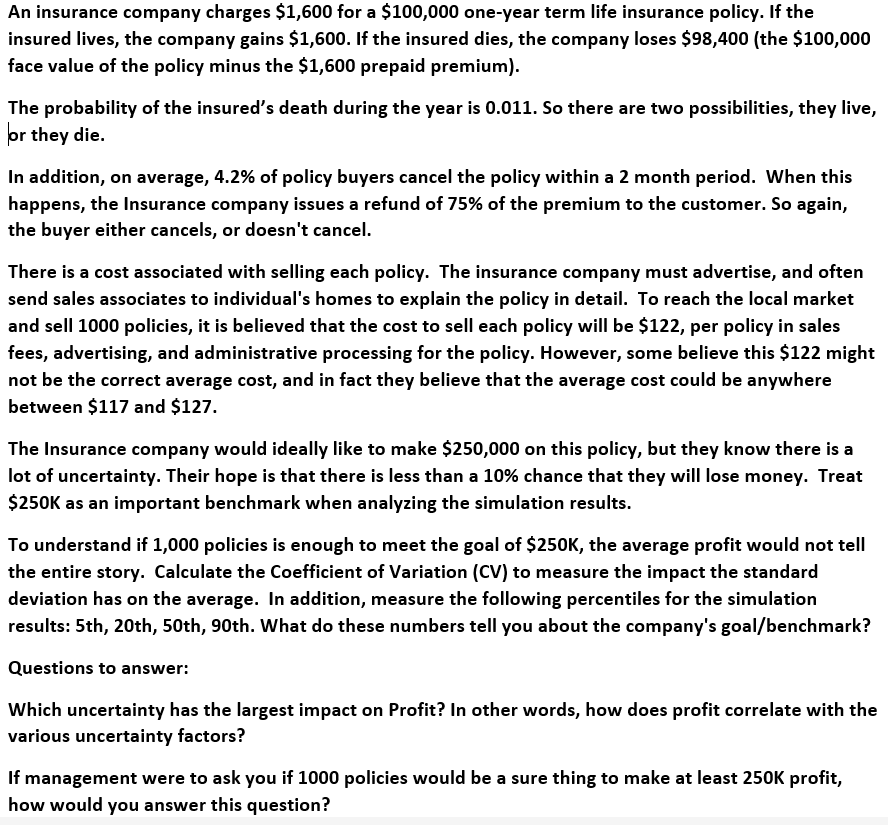
An insurance company charges $1,600 for a $100,000 one-year term life insurance policy. If the insured lives, the company gains $1,600. If the insured dies, the company loses $98,400 (the $100,000 face value of the policy minus the $1,600 prepaid premium). The probability of the insured's death during the year is 0.011. So there are two possibilities, they live, or they die. In addition, on average, 4.2% of policy buyers cancel the policy within a 2 month period. When this happens, the Insurance company issues a refund of 75% of the premium to the customer. So again, the buyer either cancels, or doesn't cancel. There is a cost associated with selling each policy. The insurance company must advertise, and often send sales associates to individual's homes to explain the policy in detail. To reach the local market and sell 1000 policies, it is believed that the cost to sell each policy will be $122, per policy in sales fees, advertising, and administrative processing for the policy. However, some believe this $122 might not be the correct average cost, and in fact they believe that the average cost could be anywhere between $117 and $127. The Insurance company would ideally like to make $250,000 on this policy, but they know there is a lot of uncertainty. Their hope is that there is less than a 10% chance that they will lose money. Treat $250K as an important benchmark when analyzing the simulation results. To understand if 1,000 policies is enough to meet the goal of $250K, the average profit would not tell the entire story. Calculate the Coefficient of Variation (CV) to measure the impact the standard deviation has on the average. In addition, measure the following percentiles for the simulation results: 5th, 20th, 50th, 90th. What do these numbers tell you about the company's goal/benchmark? Questions to answer: Which uncertainty has the largest impact on Profit? In other words, how does profit correlate with the various uncertainty factors? If management were to ask you if 1000 policies would be a sure thing to make at least 250K profit, how would you answer this question? An insurance company charges $1,600 for a $100,000 one-year term life insurance policy. If the insured lives, the company gains $1,600. If the insured dies, the company loses $98,400 (the $100,000 face value of the policy minus the $1,600 prepaid premium). The probability of the insured's death during the year is 0.011. So there are two possibilities, they live, or they die. In addition, on average, 4.2% of policy buyers cancel the policy within a 2 month period. When this happens, the Insurance company issues a refund of 75% of the premium to the customer. So again, the buyer either cancels, or doesn't cancel. There is a cost associated with selling each policy. The insurance company must advertise, and often send sales associates to individual's homes to explain the policy in detail. To reach the local market and sell 1000 policies, it is believed that the cost to sell each policy will be $122, per policy in sales fees, advertising, and administrative processing for the policy. However, some believe this $122 might not be the correct average cost, and in fact they believe that the average cost could be anywhere between $117 and $127. The Insurance company would ideally like to make $250,000 on this policy, but they know there is a lot of uncertainty. Their hope is that there is less than a 10% chance that they will lose money. Treat $250K as an important benchmark when analyzing the simulation results. To understand if 1,000 policies is enough to meet the goal of $250K, the average profit would not tell the entire story. Calculate the Coefficient of Variation (CV) to measure the impact the standard deviation has on the average. In addition, measure the following percentiles for the simulation results: 5th, 20th, 50th, 90th. What do these numbers tell you about the company's goal/benchmark? Questions to answer: Which uncertainty has the largest impact on Profit? In other words, how does profit correlate with the various uncertainty factors? If management were to ask you if 1000 policies would be a sure thing to make at least 250K profit, how would you answer this







